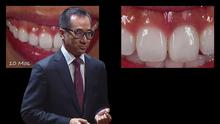-
0
Patient Assessment
- 0.1 Patient Demand
- 0.2 Anatomical location
-
0.3
Patient History
- 2.1 General patient history
- 2.2 Local history
-
0.4
Risk Assessment
- 3.1 Risk Assessment Overview
- 3.2 Age
- 3.3 Patient Compliance
- 3.4 Smoking
- 3.5 Drug Abuse
- 3.6 Recreational Drug and Alcohol Abuse
- 3.7 Condition of Natural Teeth
- 3.8 Parafunctions
- 3.9 Diabetes
- 3.10 Anticoagulants
- 3.11 Osteoporosis
- 3.12 Bisphosphonates
- 3.13 MRONJ
- 3.14 Steroids
- 3.15 Radiotherapy
- 3.16 Risk factors
-
1
Diagnostics
-
2
Treatment Options
-
2.1
Treatment planning
- 0.1 Non-implant based treatment options
- 0.2 Treatment planning conventional, model based, non-guided, semi-guided
- 0.3 Digital treatment planning
- 0.4 NobelClinician and digital workflow
- 0.5 Implant position considerations overview
- 0.6 Soft tissue condition and morphology
- 0.7 Site development, soft tissue management
- 0.8 Hard tissue and bone quality
- 0.9 Site development, hard tissue management
- 0.10 Time to function
- 0.11 Submerged vs non-submerged
- 0.12 Healed or fresh extraction socket
- 0.13 Screw-retained vs. cement-retained
- 0.14 Angulated Screw Channel system (ASC)
- 2.2 Treatment options esthetic zone
- 2.3 Treatment options posterior zone
- 2.4 Comprehensive treatment concepts
-
2.1
Treatment planning
-
3
Treatment Procedures
-
3.1
Treatment procedures general considerations
- 0.1 Anesthesia
- 0.2 peri-operative care
- 0.3 Flap- or flapless
- 0.4 Non-guided protocol
- 0.5 Semi-guided protocol
- 0.6 Guided protocol overview
- 0.7 Guided protocol NobelGuide
- 0.8 Parallel implant placement considerations
- 0.9 Tapered implant placement considerations
- 0.10 3D implant position
- 0.11 Implant insertion torque
- 0.12 Intra-operative complications
- 0.13 Impression procedures, digital impressions, intraoral scanning
- 3.2 Treatment procedures esthetic zone surgical
- 3.3 Treatment procedures esthetic zone prosthetic
- 3.4 Treatment procedures posterior zone surgical
- 3.5 Treatment procedures posterior zone prosthetic
-
3.1
Treatment procedures general considerations
-
4
Aftercare
Implant position considerations, overview
Key points
- Placement of implants in a correct three-dimensional position will allow for optimal support and stability of peri-implant bone and soft tissues.
- Placement of implants in a correct three-dimensional position is essential for a functional restoration.
- Placement of implants in a correct three-dimensional position is essential for an esthetic outcome of restoration and surrounding tissues.
Implant position considerations overview
Implant type and size should be based on site anatomy and the planned restoration. Inappropriate choice of implant length, implant diameter, implant neck configuration and surface properties may result in complications with surrounding bone, surrounding soft tissues and neighboring anatomical structures. Equally important is to place the implant of choice in the correct three-dimensional position. This will allow for optimal support and stability of peri-implant bone and soft tissues and is essential for a functional restoration and esthetic outcome.
Anatomical structures possibly encountered when replacing single teeth in the maxilla or mandible are the nasopalatine (incisive) canal/nerve, the nasal floor, the maxillary sinus, descending branches of the infraorbital nerve, the inferior alveolar nerve, the mental nerve and apical root convergence/root proximity of adjacent teeth.
Implant position must be considered three-dimensionally:
- the mesiodistal dimension: the implant body should not be closer than 1.5 mm to an adjacent root surface and not be closer to 3 mm to an adjacent implant;
- the orofacial dimension:
- anterior region: the implant shoulder is positioned 1 mm palatal to the point of emergence of adjacent teeth, aiming for at least 1.5 mm bone thickness at the labial side
- posterior region: the implant is positioned in the center of the future restoration, aiming for at least 1.5 mm of bone thickness at the buccal and palatal/lingual side
- the coronoapical dimension: the implant shoulder is positioned 3 mm apical to the emergence of the future restoration with an expected biologic width of also 3 mm, being the equivalent of 1 mm apical of the cemento-enamel junction of the contralateral tooth in patients without gingival recession.



